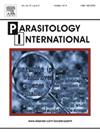Notoedres cati-induced bilateral erythemato-ceruminous otitis externa in a cat
IF 1.9
4区 医学
Q3 PARASITOLOGY
引用次数: 0
Abstract
Notoedric mange, caused by Notoedres cati (N. cati), is a rare but severe parasitic skin disease primarily affecting stray cats, with zoonotic potential. This case report describes a one-year-old intact male European Shorthair presented with extensive cervico-facial skin lesions and systemic illness signs. Clinical examination revealed severe pruritus, alopecia, thick crusts, bilateral erythemato-ceruminous otitis externa and deep pyoderma, with the maximum severity score on the clinical mange scale. Complementary tests confirmed N. cati infestation through skin scrapings and ear wax examination, alongside concurrent Toxocara cati, Dipylidium spp., and Giardia duodenalis infections. Hematological findings indicated a systemic inflammatory response. Treatment comprised topical and systemic antiparasitics (esafoxolaner, praziquantel, eprinomectin and fenbendazole), oral antibiotics (cephalexin), antipruritic therapy (prednisolone), and supportive skin care. Follow-up examinations at days 8, 12, 15, and 21 demonstrated progressive clinical improvement, with resolution of mange, endoparasitic infections, otitis, and deep pyoderma by the end of treatment. This case highlights the need for early recognition and comprehensive management of notoedric mange, particularly in stray feline populations. The observed association between N. cati infestation and otitis externa suggests that its role in feline ear disease may be underestimated.
猫双侧外耳红斑-耵聍炎。
猫爪病是由猫爪病引起的一种罕见但严重的寄生虫皮肤病,主要影响流浪猫,具有人畜共患的潜力。本病例报告描述了一只一岁的完整雄性欧洲短毛犬,表现为广泛的颈部-面部皮肤病变和全身性疾病体征。临床检查表现为严重瘙痒、脱发、厚痂、双侧外耳红斑-耵聍炎和深部脓皮病,严重程度评分最高。补充试验通过皮肤刮擦和耳垢检查证实猫奈虫感染,同时伴有猫弓形虫、双螺旋虫和十二指肠贾第鞭毛虫感染。血液学结果显示全身炎症反应。治疗包括局部和全身抗寄生虫(依普诺菌素、吡喹酮、依普诺菌素和芬苯达唑)、口服抗生素(头孢氨苄)、止痒治疗(强的松龙)和支持性皮肤护理。在第8、12、15和21天的随访检查显示,临床进展性改善,治疗结束时,坏疽、内寄生虫感染、中耳炎和深部脓皮病得到解决。这一案例强调了早期认识和全面管理非甾体病管理的必要性,特别是在流浪猫种群中。观察到的猫奈瑟螨感染与外耳炎之间的关联表明,猫奈瑟螨在猫耳疾病中的作用可能被低估了。
本文章由计算机程序翻译,如有差异,请以英文原文为准。
求助全文
约1分钟内获得全文
求助全文
来源期刊

Parasitology International
医学-寄生虫学
CiteScore
4.00
自引率
10.50%
发文量
140
审稿时长
61 days
期刊介绍:
Parasitology International provides a medium for rapid, carefully reviewed publications in the field of human and animal parasitology. Original papers, rapid communications, and original case reports from all geographical areas and covering all parasitological disciplines, including structure, immunology, cell biology, biochemistry, molecular biology, and systematics, may be submitted. Reviews on recent developments are invited regularly, but suggestions in this respect are welcome. Letters to the Editor commenting on any aspect of the Journal are also welcome.
 求助内容:
求助内容: 应助结果提醒方式:
应助结果提醒方式:


